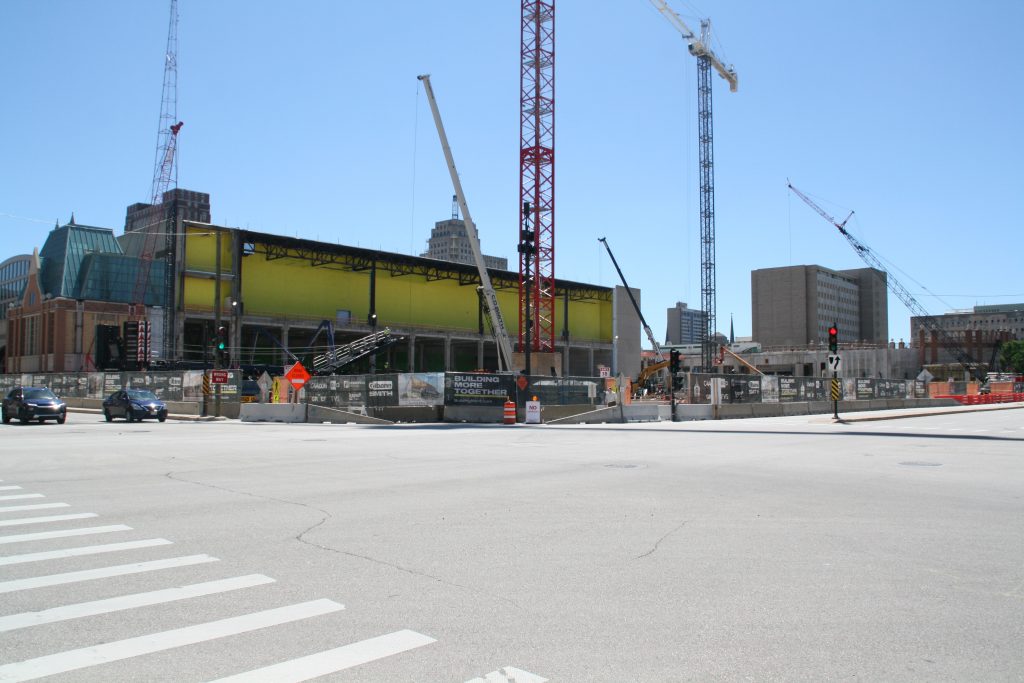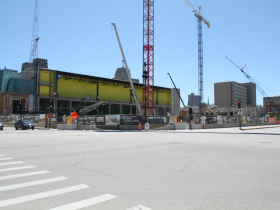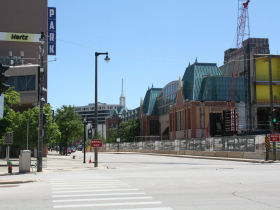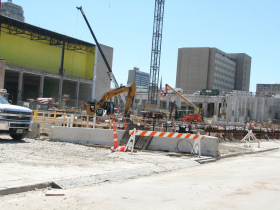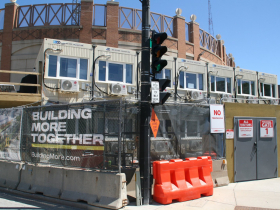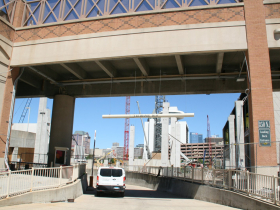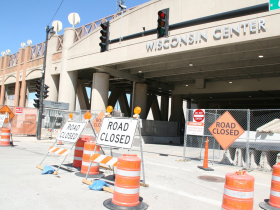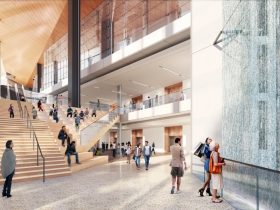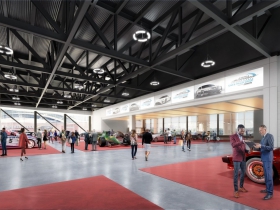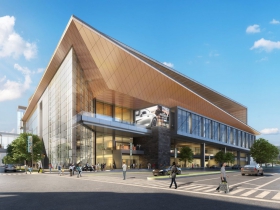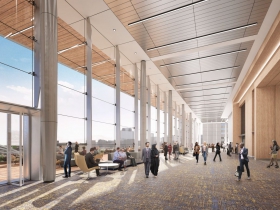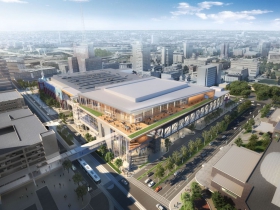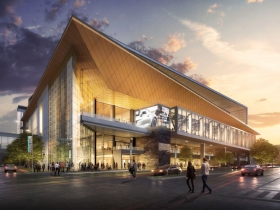$420 Million Convention Center Expansion Moving Forward
Biggest construction project in Milwaukee is just under two years from completion.
The $420 million expansion of the Wisconsin Center, “the new jewel of downtown Milwaukee,” continues to move forward, though a few different curveballs have been thrown its way.
The project will add 112,000 square feet of exhibition space to the convention center, creating a 300,000-square-foot main hall. Operationally, the facility will be able to host two conventions simultaneously. That will allow one show to load in or out while another operates, eliminating “dark” days.
The Wisconsin Center District (WCD) and VISIT Milwaukee will also have a new array of amenities to pitch in order to book more shows. Multiple outdoor decks, an indoor waterfall and revamped common spaces will wrap the convention hall. A new 2,000-person ballroom and 24 meeting rooms will also be added.
There are still nearly two years to go on the project. Construction is scheduled to be completed in early 2024 with the first events slated for May of that year.
“We’re two years away, so anything can happen,” said WCD CEO Marty Brooks in an early May interview. And plenty has.
An unidentified subcontractor made errors surveying the site. As a result, some of the 2,700 steel piles were placed in the wrong location.
“The piles, when they’re drilled in the ground during installation, are allowed to have a few inches of tolerance from their location,” said owner’s representative Mike Abrams of CAA ICON during a May 20 board meeting. He said that ranges from two to four inches. The building must sit on the piles to avoid sinking.
“Due to an initial surveying error, a larger percentage than normal were placed in the ground outside of the allowable tolerance,” said Abrams.
It was discovered in late March and mitigation measures are being put in place. That includes additional piles and larger concrete caps.
WCD is not responsible for the associated costs, which are being tracked and sent to the general contracting partnership of CD Smith and Gilbane Building Co.
Inflation, particularly acute in the construction field, is also hampering the project. Brooks told the WCD board in May was likely to go over budget without adjustments. The CEO said the bid areas seeing the greatest increases are concrete, steel, plumbing, HVAC, electrical and fire protection.
A contingency fund built into the project budget has already been exhausted and officials are exploring four options: seeking federal grants, issuing more bonds, dropping a rehabilitation of the existing convention center common areas or value engineering. The final adjustments are expected to be reviewed by the board in August, after all of the project’s bidding is complete.
The original convention center continues to operate while the expansion is being built. “We made a very deliberate business decision that we were not going to shut down,” said Brooks. “We needed to operate while we were going to do this massive project outside.”
A relatively straightforward solution was arrived at: building a series of temporary walls. It eliminated 30,000 square feet of exhibition space in the current hall. The yellow wall visible from the street has an interior wall approximately 20 feet behind it that Brooks said is difficult to detect as temporary from the inside. “It’s not like there is plastic hanging down to keep the rain out,” said Brooks. The convention business veteran said it has even confused some event bookers. “Their first reaction is when are you taking the wall down?”
Most of the construction is moving ahead just as expected.
A skywalk across N. Vel R. Phillps Ave. was removed in late 2021, to be replaced with one that aesthetically matches the new building and, more importantly, lines up with the expanded building.
Two tower cranes now float over the site, and much of Westown, and will be used to literally lift pieces of the structure into place.
A large concrete cistern, to temporarily store stormwater runoff, was poured in early May. Solar panels are planned for the building’s roof.
The building, which currently has an entrance at the corner of W. Wisconsin Ave. and N. Vel R. Phillips Ave., will be reoriented to the north with a new front door at the southwest corner of N. Vel R. Phillips Ave. and W. Kilbourn Ave. The expansion is being built atop what is currently a surface parking lot along W. Kilbourn Ave., with 400 indoor parking stalls planned as a replacement.
The project is being funded by district revenue, which includes a series of taxes in addition to rental fees. The district debt is backed by a 3% county-wide hotel room tax, 0.5% food and beverage sales tax and 3% rental car tax. The state is providing a $300 million moral obligation bond that guarantees project debt, estimated to reduce borrowing costs by up to $50 million. The district also refinanced $150 million in existing debt to create more financial capacity to take on the project. New project debt is scheduled to be repaid over 40 years.
As part of approving the expansion in April 2020, the district raised the countywide hotel tax by a half percent (to 3%) to expand its debt reserve fund. The Common Council negotiated a revenue-sharing agreement with the district as part of the expansion.
The original convention center, known then as the Midwest Express Center, was completed in 1998. Design work on the expansion is being led by a partnership of tvsdesign and Eppstein Uhen Architects.
As part of the project, WCD committed to a contracting and hiring program similar to one imposed by the City of Milwaukee on projects receiving city financial assistance. At least 25% of the work is to be committed to minority-owned businesses, 5% to women-owned businesses and 1% to veteran-owned businesses. At least 40% of project work hours will be performed by city residents or certified through the city’s Residents Preference Program (RPP) for unemployed or underemployed city workers. The work hours goal is a looser definition than the city’s 40% RPP requirement, which was required of Fiserv Forum‘s construction and all projects that receive $1 million or more in city financial support.
Photos
Renderings
More about the Wisconsin Center expansion
- Council Could Kill Revised Baird Center Revenue-Sharing Agreement - Jeramey Jannene - May 21st, 2025
- $456 Million Baird Center Opens With Big Promises, Vision - Jeramey Jannene - May 16th, 2024
- Public Can Tour Baird Center Expansion - Jeramey Jannene - May 7th, 2024
- See Inside The Massive Baird Center Expansion - Jeramey Jannene - Apr 18th, 2024
- Baird Center Selects Artists, Works To Be Displayed - Sophie Bolich - Jan 22nd, 2024
- City Hall: Council Wants New Deal, Says Convention Center ‘Outsmarted’ City - Jeramey Jannene - Oct 16th, 2023
- ‘Polka Time!’ Escalator Gets Celebratory Sendoff - Sophie Bolich - Aug 18th, 2023
- Eyes on Milwaukee: Baird Center Reaches Highest Point - Jeramey Jannene - May 11th, 2023
- Wisconsin Center Makes Deal to Save Literary Artwork - Bruce Murphy - May 1st, 2023
- Wisconsin Center Pauses Art Removal - Jeramey Jannene - Apr 14th, 2023
Read more about Wisconsin Center expansion here
Friday Photos
-
RNC Build Out Takes Over Westown
 Jul 12th, 2024 by Jeramey Jannene
Jul 12th, 2024 by Jeramey Jannene
-
Northwestern Mutual’s Unbuilding Changes Skyline
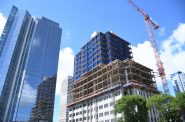 Jul 5th, 2024 by Jeramey Jannene
Jul 5th, 2024 by Jeramey Jannene
-
New Apartment Building Rises In Summerfest’s Shadow
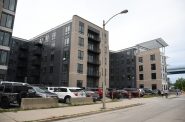 Jun 28th, 2024 by Jeramey Jannene
Jun 28th, 2024 by Jeramey Jannene


